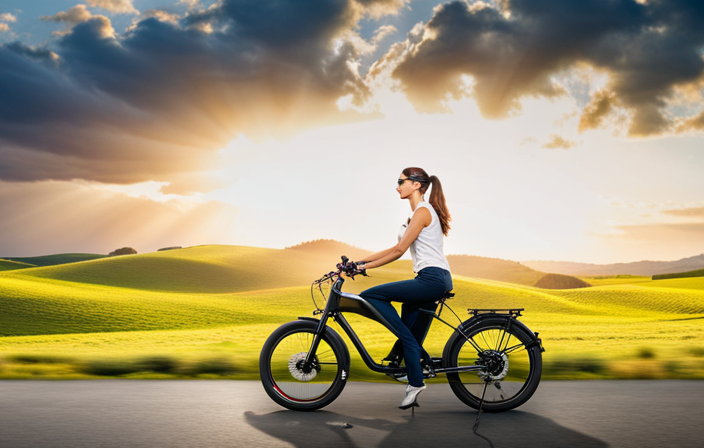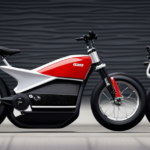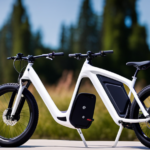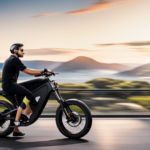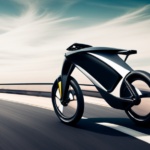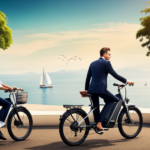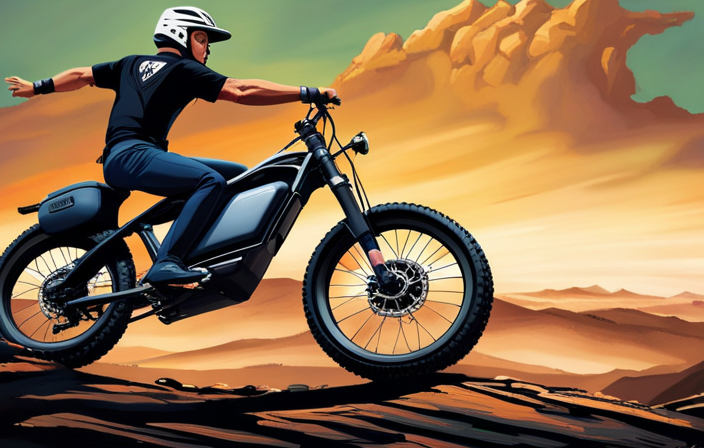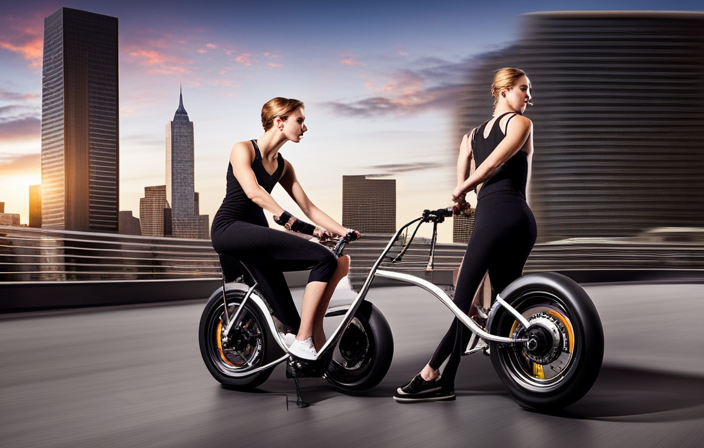Get ready to feel the wind in your hair and the thrill of speed as we dive into the world of electric bikes. These sleek machines are like lightning on two wheels, propelling riders forward with a surge of power. But just how fast can they go?
In this article, we’ll explore the factors that influence electric bike speed, classify different models based on their top speeds, and even share some tips for increasing your own electric bike’s velocity.
So buckle up, because we’re about to take off on an electrifying ride!
Key Takeaways
- Electric bike speed is influenced by factors such as the weight of the rider and bike, terrain, wind resistance, tire pressure, and battery power.
- The speed limits of electric bikes vary by country and model, with some reaching speeds of up to 28 mph.
- Electric bikes are classified into Class 1 (20 mph), Class 2 (20 mph with throttle), and Class 3 (28 mph) based on their maximum speed.
- Popular electric bike models have different top speeds, with examples including the RadRover (up to 25 mph), Turbo Levo (up to 20 mph), Cowboy (15.5 mph), Super73-RX (up to 30 mph), and Juiced Scorpion (28 mph).
Understanding Electric Bike Speed Limits
Electric bike speed limits vary depending on the country and model, with some reaching impressive speeds of up to 28 miles per hour.
Various factors can affect the top speed of an electric bike. One important factor is the weight of the rider and the bike itself. The heavier the load, the slower the bike will go. This is because the electric motor has to work harder to propel the bike forward.
Other factors that can impact speed include the terrain, wind resistance, tire pressure, and battery power. Understanding these factors can help riders maximize the speed and performance of their electric bikes.
Moving on to the next section, let’s explore the different factors that influence electric bike speed.
Factors That Influence Electric Bike Speed
To experience the thrill of riding an e-bike at its top speed, you’ll need to consider various factors that can influence how swiftly you zip through the streets. Electric bike speed can vary depending on the terrain you’re riding on. Uphill climbs will naturally slow you down, while flat and smooth roads will let you reach higher speeds.
Another factor that affects electric bike speed is the weight of the rider. Heavier riders may experience a slight decrease in speed compared to lighter riders. Additionally, the battery power and motor capacity of the e-bike play a role in determining how fast it can go. These factors collectively contribute to the overall speed capabilities of an electric bike.
Moving forward, let’s delve into the classification of electric bikes by speed.
Classifying Electric Bikes by Speed
When it comes to electric bikes, they can be classified into three main categories based on their speed.
The first category is Class 1 Electric Bikes, which have a top speed of 20 mph. These bikes provide assistance through pedaling and are ideal for those who want to enjoy a moderate level of exercise while still getting some assistance.
The second category is Class 2 Electric Bikes, which also have a top speed of 20 mph but come with a throttle option. This means that riders can choose to use the throttle to propel the bike without pedaling.
Lastly, we have Class 3 Electric Bikes, which have a higher top speed of 28 mph. These bikes are designed for more experienced riders who want to cover longer distances in less time.
Class 1 Electric Bikes (20 mph)
Get ready to zip around at speeds of up to 20 mph on a Class 1 electric bike!
Class 1 electric bikes are one of the most popular electric bike models available today. They are designed to provide assistance while pedaling, giving riders an extra boost to reach higher speeds.
With their speed capabilities of up to 20 mph, Class 1 electric bikes are perfect for commuters who want to get to their destination quickly and efficiently. These bikes are also great for recreational riders who enjoy the thrill of fast-paced riding.
Class 1 electric bikes are equipped with a motor that provides assistance up to 20 mph, ensuring a smooth and enjoyable ride.
Now, let’s transition into the subsequent section about Class 2 electric bikes (20 mph with throttle).
Class 2 Electric Bikes (20 mph with throttle)
Zoom around at speeds of up to 20 mph with a Class 2 electric bike, igniting a thrilling rush of adrenaline! With throttle control, you have the power to effortlessly accelerate and maintain your desired speed.
Here are three performance enhancements that make Class 2 electric bikes stand out:
-
Enhanced Speed: The throttle feature allows you to reach and maintain a top speed of 20 mph, making your ride faster and more exciting.
-
Easy Maneuverability: With precise throttle control, you can easily navigate through traffic or conquer challenging terrains with confidence and ease.
-
Instant Boost: The throttle provides an instant boost of power whenever you need it, ensuring a seamless ride and effortless acceleration.
Transitioning into the next section, Class 3 electric bikes take your speed to new heights, reaching up to 28 mph without compromising on safety.
Class 3 Electric Bikes (28 mph)
Blasting down the road like a lightning bolt, Class 3 electric bikes unleash a thrilling burst of speed, reaching up to 28 mph. These high-powered e-bikes have become increasingly popular among thrill-seekers and commuters alike. One of the key factors that sets Class 3 electric bikes apart is their upgraded motor power, which allows them to achieve higher speeds compared to Class 2 models. However, it’s important to note that the top speed of 28 mph may be subject to speed limitations in different countries. For instance, in some countries, the maximum speed for electric bikes is capped at 20 mph. Therefore, riders must be aware of the regulations in their specific location to ensure they are riding within the legal limit. Moving on to the subsequent section about popular electric bike models and their speeds, we will explore even more exciting options in the world of e-bikes.
Popular Electric Bike Models and Their Speeds
One popular electric bike model, the RadRover, can reach impressive speeds. With its upgraded battery capacity, this electric bike can go up to 25 mph, providing a thrilling riding experience.
But it’s not just the RadRover that offers impressive speeds. Here are some other popular electric bike models and their speeds:
-
Turbo Levo: This electric mountain bike can reach speeds of up to 20 mph, making it perfect for off-road adventures.
-
Cowboy: With a top speed of 15.5 mph, this sleek and stylish electric bike is designed for urban commuting.
-
Super73-RX: This retro-inspired electric bike can reach speeds of up to 30 mph, combining style and performance.
-
Juiced Scorpion: With a top speed of 28 mph, this electric bike offers a powerful ride for those seeking speed.
Upgrading battery capacity and reducing weight can have a significant impact on the speed performance of electric bikes. To learn more about increasing electric bike speed, check out the next section on tips and tricks.
Tips for Increasing Electric Bike Speed
When it comes to increasing the speed of an electric bike, there are a few key points to consider.
First, regular maintenance and maintaining proper tire pressure are essential. This includes checking the chain, brakes, and gears regularly and ensuring that the tires are inflated to the recommended pressure.
Secondly, using pedal assist efficiently can greatly enhance the speed of an electric bike. Finding the right level of assistance and actively pedaling can make a significant difference in how fast the bike can go.
Lastly, for those looking for a more significant boost in speed, upgrading the motor or battery components may be necessary. This can provide a higher level of power and allow for faster acceleration and higher top speeds.
Regular Maintenance and Tire Pressure
To ensure optimal performance, it’s important to regularly maintain your electric bike, including checking the tire pressure. Proper maintenance is crucial to keep your electric bike running smoothly and efficiently. One of the key maintenance tips is to regularly inspect the tires and ensure they are properly inflated.
Maintaining the correct tire pressure is essential for a smooth and comfortable ride. It not only improves the overall performance of the bike but also extends the lifespan of the tires. Riding with low tire pressure can lead to increased rolling resistance, reduced battery efficiency, and a less enjoyable riding experience.
By keeping your tires properly inflated, you can maximize the speed and efficiency of your electric bike.
Moving on to the next section, let’s discuss how to use pedal assist efficiently.
Using Pedal Assist Efficiently
Get ready to turbocharge your ride with the most efficient use of pedal assist. Efficient pedaling is key to improving speed on an electric bike. When using pedal assist, it’s important to maintain a steady cadence and apply consistent pressure on the pedals. This allows the motor to provide the optimal amount of power to assist your pedaling.
Additionally, shifting gears appropriately can also help in maintaining an efficient pedaling rhythm. By shifting to a lower gear when going uphill or against strong headwinds, you can make the most of the motor’s assistance and maintain a higher speed. On the other hand, shifting to a higher gear when riding on flat terrain or going downhill can help you conserve battery power and improve overall efficiency.
By mastering efficient pedaling techniques, you can maximize the speed and performance of your electric bike. Now, let’s explore how upgrading motor or battery components can further enhance your riding experience.
Upgrading Motor or Battery Components
Enhancing your riding experience can be achieved by upgrading the motor or battery components on your electric bike. Here are four ways upgrading can improve your electric bike performance:
-
Upgrading battery capacity: By increasing the battery’s capacity, you can extend your electric bike’s range and ride for longer distances without worrying about running out of power.
-
Improving motor performance: Upgrading the motor can provide you with more power and torque, allowing you to tackle steep inclines and challenging terrains with ease.
-
Enhancing speed: Upgrading the motor or battery can increase the top speed of your electric bike, providing you with a faster and more exhilarating ride.
-
Boosting acceleration: Upgrading the motor or battery components can also improve the acceleration of your electric bike, making it more responsive and enabling you to quickly reach higher speeds.
By upgrading these components, you can enjoy a more powerful and efficient electric bike. Now, let’s explore the legal regulations and speed limits for electric bikes.
Legal Regulations and Speed Limits for Electric Bikes
When it comes to electric bikes, it’s important to understand the legal regulations and speed limits that apply.
Local and state laws play a crucial role in determining how fast you can go on your electric bike, as well as where you can ride it.
Additionally, international regulations may also come into play if you plan on riding your electric bike in different countries.
It’s essential to familiarize yourself with these regulations to ensure you stay within the legal boundaries and have a safe riding experience.
Local and State Laws
Riding an electric bike, you’ll zoom through local and state laws like a lightning bolt, effortlessly navigating the legal requirements. To ensure a smooth ride, it’s important to understand the specific regulations that govern electric bikes in your area.
Here are some key points to keep in mind:
- Different states have different definitions of what constitutes an electric bike, so make sure yours aligns with the legal requirements.
- Speed limits for electric bikes vary, but they generally range from 20 to 28 miles per hour.
- Some states require electric bikes to have certain safety features, such as lights, reflectors, and a horn.
- Enforcement measures for electric bike violations can include fines, points on your driver’s license, or even confiscation of the bike.
- It’s crucial to familiarize yourself with the local laws, as they may differ from state regulations.
Understanding these local and state laws will help you ride your electric bike with confidence and avoid any legal complications.
Moving on to international regulations…
International Regulations
Now that we have discussed the local and state laws regarding electric bike speed restrictions, let’s turn our attention to the international regulations.
It is important to note that each country may have its own legal requirements and speed restrictions when it comes to electric bikes. Some countries have specific laws governing the maximum speed an electric bike can reach, while others may classify electric bikes differently, depending on their power output and speed capabilities.
For example, in Europe, electric bikes are generally limited to a maximum speed of 25 kilometers per hour (15.5 miles per hour), after which they are considered mopeds and subject to different regulations.
Understanding the legal requirements and speed restrictions in different countries is crucial for electric bike riders who plan to travel internationally. This knowledge will ensure compliance with local laws and promote safe riding practices.
Speaking of safety considerations at higher speeds…
Safety Considerations at Higher Speeds
At higher speeds, it’s important to be aware of safety considerations on an electric bike. Many people have misconceptions about high-speed electric biking, thinking that it’s just like riding a regular bike. However, the increased speed of an electric bike requires extra precautions to ensure a safe ride. One of the most important safety measures is wearing appropriate safety gear. This includes a helmet, knee and elbow pads, and reflective clothing to increase visibility. Additionally, it’s crucial to have a good understanding of the bike’s capabilities and limitations, as well as the rules and regulations for electric bike use in your area. Being mindful of road conditions, such as potholes or debris, is also essential at higher speeds. By taking these safety considerations seriously, riders can enjoy the benefits of riding at different speeds without compromising their well-being.
Benefits of Riding at Different Speeds
Zooming along on an electric bike at varying speeds is like dancing to the rhythm of the wind, offering riders a thrilling sense of freedom and exhilaration. Riding at different speeds can bring a range of benefits, including increased stamina and improved cardiovascular health.
Here are a few reasons why riding at different speeds can be advantageous:
- Increased Stamina: Riding at higher speeds challenges your body, helping to build endurance and increase overall stamina.
- Cardiovascular Health: Riding at a brisk pace gets your heart pumping, improving cardiovascular fitness and strengthening your heart.
- Variety: Riding at different speeds keeps things interesting and prevents boredom, making your rides more enjoyable.
- Progressive Training: Alternating between slower and faster speeds allows for progressive training, helping you to continually improve your fitness level.
- Exploration: Riding at different speeds allows you to explore more areas and cover more ground, giving you the opportunity to discover new places and routes.
By riding at different speeds, you can experience the full range of benefits that electric bikes have to offer.
Now, let’s address some common misconceptions about electric bike speed.
Misconceptions About Electric Bike Speed
When it comes to electric bike speed, there are some common misconceptions that need to be addressed.
One misconception is comparing electric bikes to motorcycles and cars in terms of speed. While electric bikes can reach high speeds, they are not designed to compete with motorized vehicles.
Another misconception is overestimating the speed capabilities of electric bikes. While they can reach impressive speeds, it’s important to understand that there are limitations due to factors such as weight and power.
Understanding the difference between speed and power is also crucial. Electric bikes may not have the same acceleration as motorcycles or cars, but they can still provide a thrilling and efficient mode of transportation.
Comparisons with Motorcycles and Cars
Compared to motorcycles and cars, electric bikes can reach impressive speeds. Here are four reasons why electric bikes can hold their own when it comes to speed:
-
Speed Limit: Electric bikes can often reach speeds of up to 20 mph, which is comparable to the speed limit in many urban areas. This allows riders to keep up with traffic flow effortlessly.
-
Acceleration: Electric bikes offer quick acceleration, allowing riders to easily navigate through congested city streets or overtake slower vehicles.
-
Maneuverability: Electric bikes are smaller and more agile than cars, making them ideal for weaving through traffic or navigating tight spaces.
-
Efficiency: Electric bikes are designed to maximize efficiency, allowing riders to cover longer distances in less time compared to cars or motorcycles.
While electric bikes may not match the top speeds of motorcycles or cars, their speed capabilities should not be underestimated.
Next, let’s explore the common misconception of overestimating speed capabilities.
Overestimating Speed Capabilities
Don’t be fooled by the sleek design and impressive performance of electric bikes; it’s easy to overestimate their speed capabilities. While electric bikes can certainly provide a thrilling ride, it’s important to understand the limitations.
One of the common misconceptions about electric bike speed is that they can match the speeds of motorcycles or cars. However, this is not the case. Electric bikes typically have a top speed of around 20 to 28 miles per hour, depending on the model. This is significantly lower than the speeds that motorcycles and cars can reach.
It’s important to manage expectations and remember that electric bikes prioritize efficiency and sustainability over raw speed. Understanding the difference between speed and power will help you make informed decisions when it comes to electric bikes.
Understanding Speed vs. Power
Overestimating the speed capabilities of an electric bike can lead to disappointment and frustration. It is important to understand the relationship between speed and power when it comes to electric bikes.
The speed of an electric bike is determined by various factors, including the power of the motor and the weight of the rider. Higher power motors are capable of achieving higher speeds, but the weight of the rider can have an impact on the overall speed. Heavier riders may experience slightly slower speeds compared to lighter riders.
Additionally, the speed of an electric bike can also vary depending on the distance traveled. As the battery drains, the speed may decrease. Understanding these factors can help manage expectations and ensure a more enjoyable riding experience.
Looking ahead, let’s explore the future trends in electric bike speed technology.
Future Trends in Electric Bike Speed Technology
To truly understand the potential of future electric bike speed technology, you might want to consider the advancements in battery power and motor efficiency. These two factors play a crucial role in determining how fast an electric bike can go.
With upcoming advancements in battery technology, we can expect to see electric bikes with longer range and higher speeds. Manufacturers are constantly working on improving the energy density and efficiency of batteries, allowing them to store more power and deliver it to the motor more effectively.
Additionally, motor technology is also evolving rapidly, with more powerful and compact motors being developed. These advancements have already led to electric bikes breaking speed records, and we can only expect this trend to continue in the future.
As battery and motor technology continues to improve, we can look forward to electric bikes that are faster and more efficient than ever before.
Frequently Asked Questions
Are electric bikes allowed to go as fast as regular bicycles?
Electric bikes are subject to speed regulations, just like regular bicycles. The electric bike speed limits vary depending on the country and local regulations. It’s crucial to adhere to these speed restrictions for safety and legal reasons.
Can I modify my electric bike to increase its speed?
Yes, you can modify your electric bike to increase its speed. There are various electric bike modifications available, such as upgrading the motor, improving the battery, or optimizing the aerodynamics, that can enhance the overall speed and performance of your electric bike.
How fast do electric bikes typically go when going uphill?
When going uphill, electric bikes typically maintain a slower speed compared to flat terrain. The power and torque of electric bike motors, along with battery life, play a crucial role in determining the speed on inclines.
Are there any safety concerns when riding an electric bike at high speeds?
When riding an electric bike at high speeds, it is important to take safety precautions and ensure proper handling. This includes wearing protective gear, maintaining control of the bike, and being aware of potential hazards on the road.
What are the potential legal consequences of exceeding the speed limit on an electric bike?
Exceeding the speed limit on an electric bike can result in legal penalties such as fines and even the suspension of a driver’s license. Additionally, insurance coverage may be affected if accidents occur while speeding.
Conclusion
In conclusion, understanding electric bike speed limits is essential for a thrilling and efficient ride. Factors such as motor power, weight, and terrain influence the speed of electric bikes. By classifying electric bikes based on their speeds, riders can choose the perfect model for their needs.
Popular electric bike models offer varying speeds, from a leisurely cruise to an adrenaline-pumping sprint. To increase electric bike speed, consider upgrading the motor or optimizing the battery usage. However, safety should always be a top priority when riding at higher speeds.
Riding at different speeds offers unique benefits, from exploring scenic routes to getting a heart-pumping workout. Despite misconceptions, electric bikes are not slow and can reach impressive speeds. As technology continues to advance, future trends in electric bike speed will surely push the limits even further.
So, hop on your electric bike and enjoy the exhilarating ride ahead!

